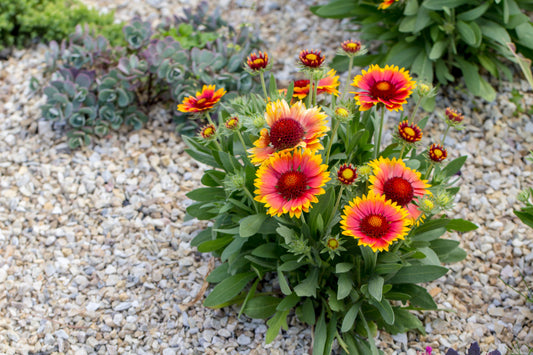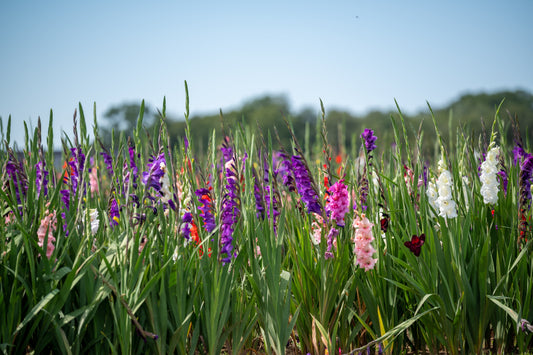Daffodils Planting & Growing Guide
Planting Guide Information
-
Species dependent; Top 1" bulb exposed indoors, 3-6" deep outdoorsPlanting Depth
-
3" ApartPlanting Proximity
-
Fall to WinterPlanting Season
-
Early spring charmers that are loved by many gardeners. Plus they are so easy to grow!Plant Benefits
-
Moderate with growthWater Quantity
-
Blooms early spring outdoorsBloom Season
-
Bright Direct for indoor forcing; Full to partial sun outdoorsSunlight Quantity
-
Varies, species dependent; Zones 3-9Hardiness Zones
Additional Growing Information
Where to Plant
While Daffodils are incredibly easy to grow, plenty of sunlight and well-drained soil are key to their happiness. If you notice puddles of water 5–6 hours after a hard rain, scout out another site or amend the soil with organic material to raise the level 2–3 inches. Daffodils fancy a spot where they will receive sun for all or most of the day.
When to Plant
Plant your Daffodil bulbs from September through December outdoors. These beauties are tough as nails and will tolerate being planted in 100-degree or 40-degree soil. You can expect roots to form in the fall, with buds and flowers emerging in the spring. Those gardening in warm regions may notice some foliage in the fall on select varieties.
How to Plant
- For outdoor landscape planting, find a spot where the soil drains well, and your Daffodils will receive full sun for all or most of the day. Dig holes and tuck the bulbs into the ground with the pointed tops 3–6" below the soil surface facing upward. Place smaller bulbs more shallowly than larger ones, allowing 4–5 bulbs per square foot.
- For container planting, select a vessel large enough to accommodate the mature size of your plants and fill it with good quality, well-drained soil—almost any commercially available potting medium will work fine. Ensure there are adequate drainage holes in your pots, as Daffodils must never sit in waterlogged soil. Dig holes and tuck the bulbs into the soil with their pointed tops 3–6" below the soil surface facing upward. Place smaller bulbs more shallowly than larger ones, allowing 6–8 bulbs per square foot.
- Water thoroughly after planting, soaking the soil to settle it around the bulbs.
How to Grow
- Water as needed during active growth periods; about 1" of moisture per week is a good estimate.
- Leave the foliage in place at the end of the blooming season rather than cut it off. The leaves will gather sunlight to create food through photosynthesis, strengthening the bulbs for the future.
- Remove the foliage around late spring or early summer when it turns yellow and dies back as the plant slips into dormancy.
- Allow your Daffodils to rest for a few months before beginning the next growing cycle.
Daffodil Tips & Tricks
- Amend the soil with compost, finely ground bark, or decomposed manure to improve the drainage as needed.
- Feel free to snip stems for bouquets while in bloom, as doing so will not hurt the plants, and Daffodils are exceptional for arrangements.
- Help mitigate the effects of both very cold nights and big temperature swings by overwintering container-planted bulbs in an unheated garage in zones 6 and colder.
- Pull overwintered pots outside in late February or March and wait for the sprouts to appear!
- Avoid mixing Daffodils with other spring flowers in cut arrangements. The sap produced by these bright bloomers contains a chemical that causes other blooms in the same vase to wilt.
From the Family
-
Daffodil & Tulip - Evening Breeze Blend
10 Tulip Bulbs & 10 Daffodil BulbsRegular price $19.72Sale price $19.72 Regular priceUnit price per$32.9041% Off -
Narcissus - Daffodil Yellow Cheerfulness
10 Daffodil BulbsRegular price $11.97Sale price $11.97 Regular priceUnit price per$19.9540% Off -
 40% Off
40% OffNarcissus - Daffodil Jetfire
10 Daffodil BulbsRegular price $8.97Sale price $8.97 Regular priceUnit price per$14.9540% Off -
 40% Off
40% OffNarcissus - Daffodil Carlton
10 Daffodil BulbsRegular price $8.97Sale price $8.97 Regular priceUnit price per$14.9540% Off -
 40% Off
40% OffNarcissus - Daffodil Geranium
10 Daffodil BulbsRegular price $8.97Sale price $8.97 Regular priceUnit price per$14.9540% Off








